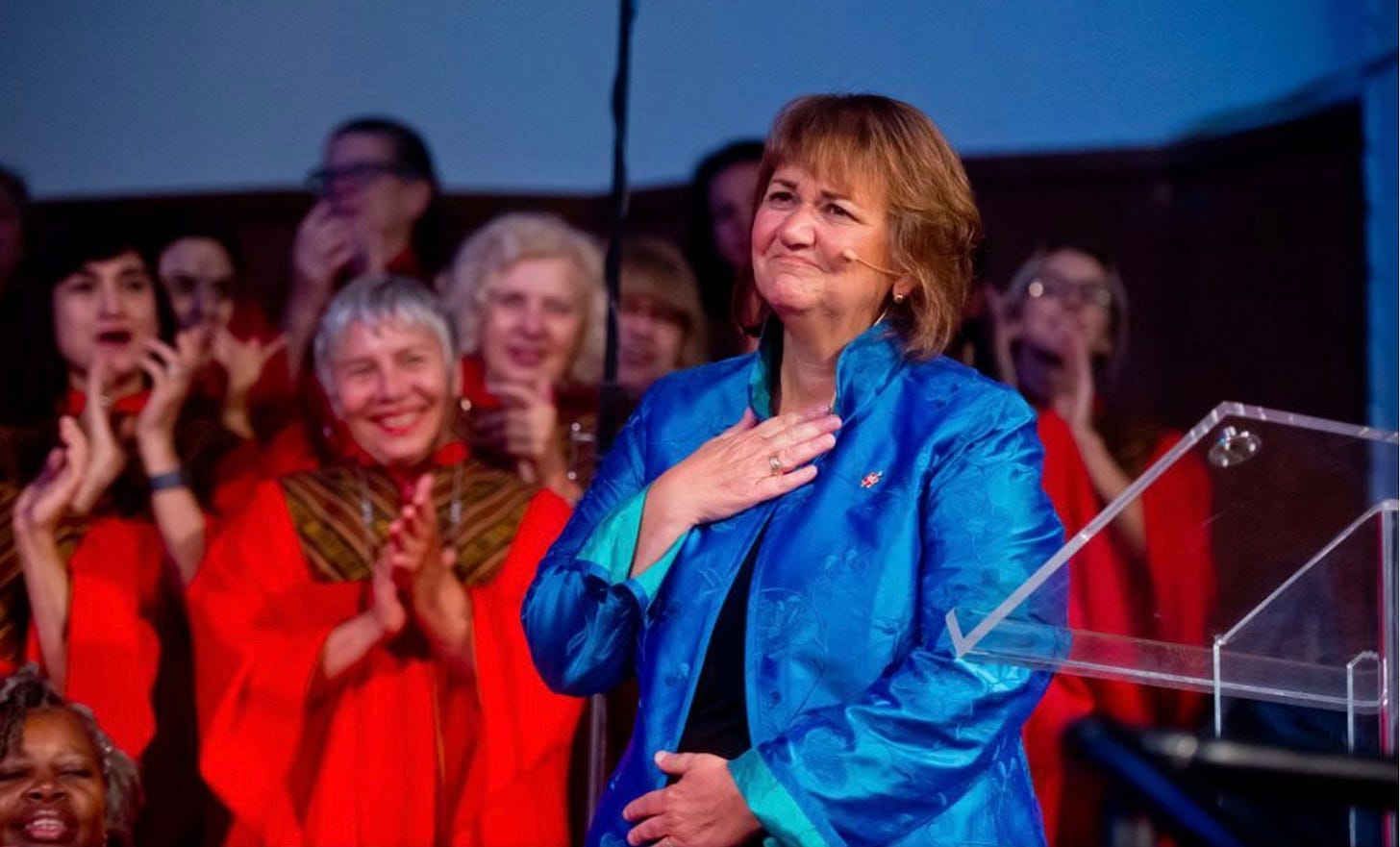United Methodist Church delegates sang and danced to “Love Train” at the final day of their general conference in the spring. Paul Jeffrey/UMNews
The United Methodist Church is in a death spiral!
If John and Charles Wesley were alive today, they would be driving false teachers from pulpits and pews. The Wesleys would be outraged and incredulous at the idea of stating one’s pronouns as happened in late April at the 2024 general conference in Charlotte, N.C.
The alphabet mafia broke Methodists. However, the foundation had been set since the Civil War because this once strong Mainline Protestant denomination has lost its way.
The UMC boasted more than 11 million members in 1967. However, Ryan Burge, an American Baptist minister who produces graphs on faith and is an assistant professor at Eastern Illinois University, produced a graph that serves as a UMC epitaph:
I shot a straight line through the membership stats of the United Methodist Church, starting in 1967 and extending it through 2050. It predicted that the UMC would hit 4.9 million members in 2038. Instead, they hit that number in 2023. That's the fall out of the schism.
In 2019, The UMC granted disaffiliation to churches over human sexuality. Those disaffiliations ended Dec. 31, 2023, with 25 percent of churches, more than 7,600, and 24 percent of membership, leaving the UMC, the Lewis Center found. The Lewis Center is connected to the Wesleyan wing of the Methodist Church. Of the UMC’s five regions, the following reveals the percentage of churches that disaffiliated:
Southeastern: 50 percent
Southern: 21 percent
North Central: 18 percent
Northeast: 10 percent
Western: 1 percent
How did Methodists reach this point?
Christopher Evans is a professor at Boston University and is widely published on issues with American churches. He focused on social issues dividing Methodists. His analysis was published at Religion Unplugged before the UMC general conference.
John Lomperis earned his bachelor's degree in Religious Studies from the University of Chicago, and has an M. Div from Harvard University. He is the United Methodist director for the Institute for Religion and Democracy. Juicy Ecumenism published an analysis in January 2021 on the UMC schism. Lomperis identified a breakdown of discipline and doctrine on slavery, cultural Christianity, and at a minimum false teaching, and some would say, heresy in more recent years.
Slavery
Evans and Lomperis chronicle how John Wesley was an abolitionist. Lomperis wrote:
The 1784 Christmas Conference that established American Methodism as our own denomination declared that one of the key goals of this new church was to ‘extirpate the abomination of slavery.’ Our early rules were clear that Methodists were forbidden from buying, selling, or owning slaves.
Evans wrote:
At the 1844 General Conference, the slavery issue boiled over into a major schism. Delegates voted to remove from office a bishop, James Osgood Andrew, because he owned slaves. Andrew’s removal angered Southern delegates who argued that slavery was sanctioned in the Bible. In 1845, Southern Methodist leaders withdrew from the denomination, forming the Methodist Episcopal Church South.
Discipline and Doctrine
Lomperis wrote that as the UMC lost members to the Holiness Movement, and modernists controlled denomination instruction and communication, this led to compromise on orthodoxy. Events in the UMC culminated in 1966, when the Rev. Charles Keysor of Illinois identified five fundamentals that modernists attacked for 50 years. They are:
The inspiration and authority of Scripture;
That Jesus really was miraculously born of a Virgin;
‘That somehow Christ on the cross paid the price of transgression which a righteous and holy God properly requires”;
That Jesus actually, physically rose from the dead;
And that whatever the details of the End Times may turn out to be, Jesus really will physically return to Earth again.
Karen Oliveto said goodbye to Glide Memorial United Methodist Church in San Francisco in Aug. 2016 after being elected UMC bishop in July 2016. Alain McLaughlin Photography Inc. via UM News.
Heresy
Lomperis revealed early 21st century issues that dropped on this Mainline Protestant denomination focused on doctrine and LGBTQ issues that emerged center stage for the nation, not just churches.
In the early 2000s, Bishop Joseph Sprague publicly denied “core Christian doctrines as the accuracy of the Gospel of John, as well as the virgin birth, substitutionary atonement, and physical resurrection of Jesus Christ.” Sprague walked away with a slap on the wrist, he wrote.
In 2016, Karen Oliveto, a lesbian from the Western Region, was named a bishop. Lomperis stated she gained attention in 2005 at a conference he attended:
I was in the room where she was speaking at a major national gathering of liberal United Methodists. Among other things, she urged addressing both ‘the benefits and flaws’ of Scripture. What do you mean ‘flaws’ of Scripture? Well, she made clear that one flaw she saw in the Bible was the ‘theology of election and chosen-ness’ she rightly recognized is taught in the Bible. It got really bizarre when Oliveto started teaching about the account in Acts 16 of Paul casting a demon out of a slave girl. According to Oliveto, getting to be free of the demon did nothing to make the girl’s life better and ‘probably made it worse.’
Lomperis reported Oliveto used her position to also say “Jesus actually had such sins as ‘his bigotries and prejudices’ and that as an adult, he needed to experience ‘conversion.’ ”
It led to compromise on gay clergy, gay marriage, church disaffiliations, and the UMC removing from its Book of Discipline: "The practice of homosexuality is incompatible with Christian teaching."
After the 2024 conference, Cote d'Ivoire removed its 1 million members from the UMC, and South Korea could follow.
When a Christian denomination strays so horribly from orthodoxy, don’t wonder why they hemorrhage membership.






